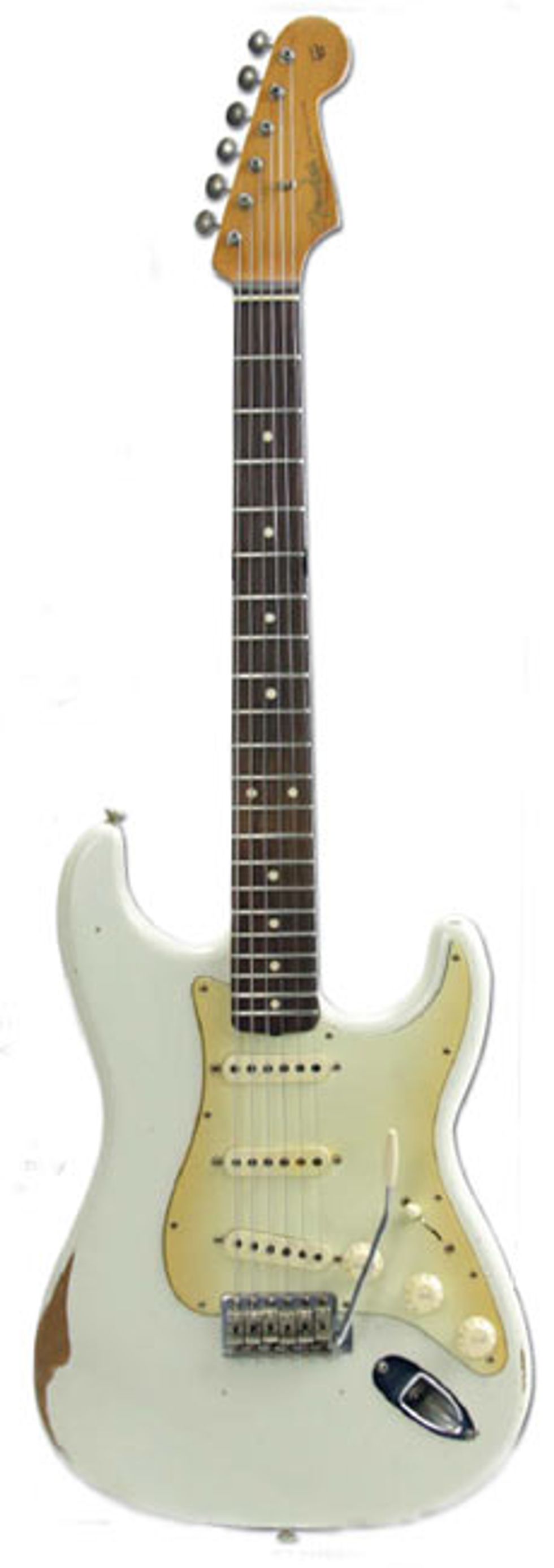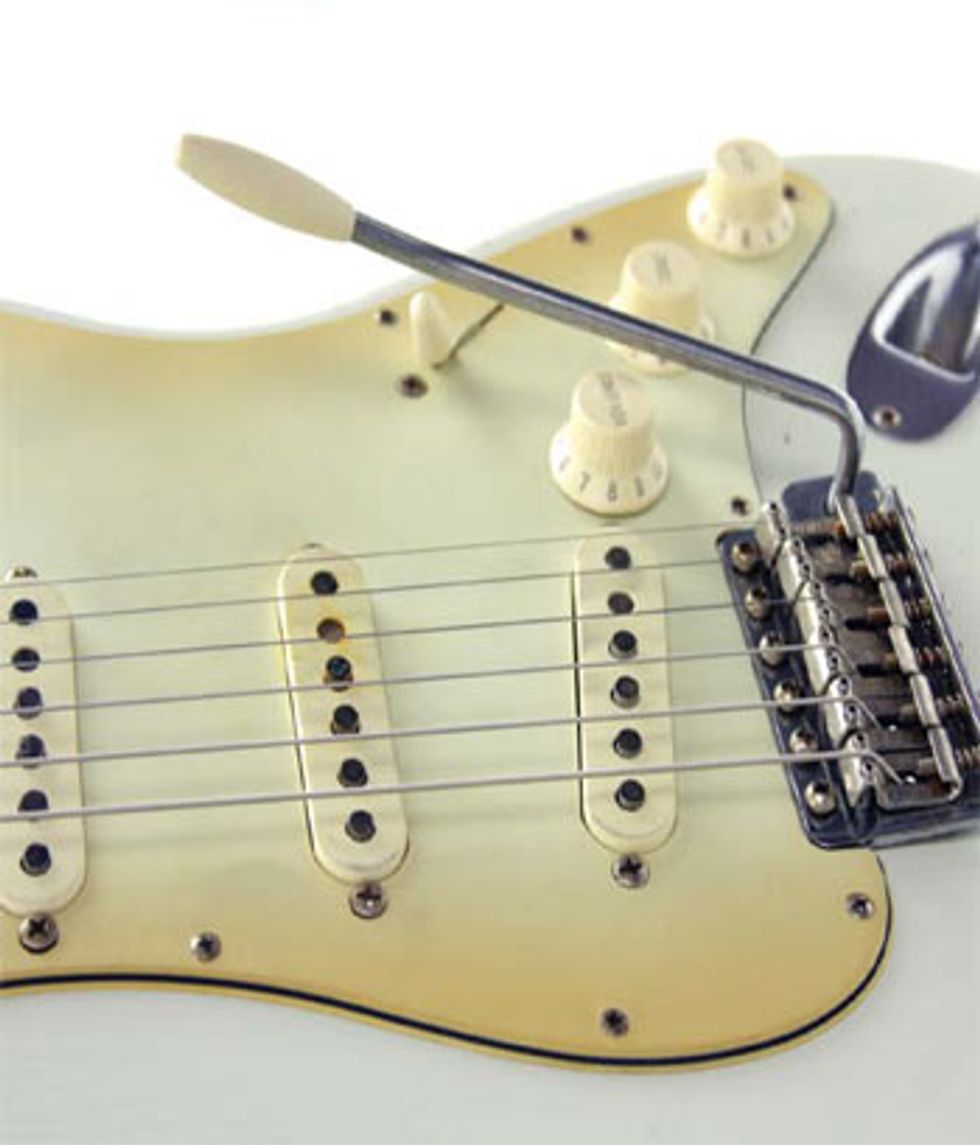 | |
| Download Example 1 | |
| Download Example 2 | |
| Fender Road Worn '60s Strat through a Fender Twin Reissue | |
This admiration for beaten and bruised guitars has even created a trend in new guitars, but the phenomenon is fairly recent, when put into context. Fender and Gibson have been producing beaten-up versions of their instruments for several years now. In the late 90s, the Fender Custom Shop introduced the Relic series, which were highly accurate reproductions of their vintage designs, but purposefully worn to replicate the feel of an actual guitar from the ‘50s or ‘60s. The idea was apparently inspired by Keith Richards, who told Fender that the replica instruments he’d received “looked too new” and that he wanted them to be worn out before he’d play them, so that he couldn’t feel or see the difference. Going even further, guitarists can now buy instruments that actually replicate the exact scratches, dings, and worn finishes of some of their favorite artists’ guitars.
New, old-looking guitars can fetch thousands of dollars due to the comfortable feel of the neck, worn edges on the hardware, and of course, the look of cigarette smoke stains and finish dings from rowdy gigs and deflected beer bottles. Now that the demand for vintage-inspired, worn guitars has reached a peak, Fender is introducing an affordable line of their flagship models, complete with all the tarnished hardware, finish checking, and corrosion-encrusted vibe of those instruments.
’60s Stratocaster [Read our '50s Telecaster Review]
The specimen we received is Olympic White, based on a ‘60s model, with a C-shaped neck and vintage-style tuning machines. The guitar is very striking, with the white body immediately setting off the yellowed plastic hardware and spots of worn finish. Even the tremolo arm has received a treatment, as the metal is lightly tarnished (but smooth) and the tip aged to match the matured pickguard and control knobs. With closer inspection smaller details come into focus, such as the lightly corroded neck plate, tarnished pickguard screws, and worn tuners and bridge saddles. The only part of the instrument that doesn’t look like it’s been subjected to harsh treatment is the fretboard. The rosewood has a nice, healthy color and the frets are polished and fit to perfection.
 Running a pair of fingers over the body revealed the wounds to be real, some deeper than others. The distressed finish can certainly be differentiated from the feel of the bare wood, which adds to the effect Fender is aiming for. The back of the neck was a different story, however. Possibly the most important characteristic of a vintage guitar is the way the neck feels in the player’s hand— it can make or break the decision to buy. While the edges of the fretboard felt like they’d been rolled off to maximize comfort, the worn parts on the back of the neck didn’t really feel different from the areas where the lacquer is easily visible. Although there are heavily worn areas on the neck, the un-worn areas felt exactly the same, as if the finish had been worn away, then sealed over again. It seems to detract from the purpose of replicating those worn areas for comfortable feel and grip that players used to have to work so long and hard to create. Up close, the worn away portions of the back of the body seemed a little contrived, as well. This might have more to do with the fact that it was white, as the Tele seemed more accurate with its worn yellow-to-white-primer areas (more on that in our Tele review).
Running a pair of fingers over the body revealed the wounds to be real, some deeper than others. The distressed finish can certainly be differentiated from the feel of the bare wood, which adds to the effect Fender is aiming for. The back of the neck was a different story, however. Possibly the most important characteristic of a vintage guitar is the way the neck feels in the player’s hand— it can make or break the decision to buy. While the edges of the fretboard felt like they’d been rolled off to maximize comfort, the worn parts on the back of the neck didn’t really feel different from the areas where the lacquer is easily visible. Although there are heavily worn areas on the neck, the un-worn areas felt exactly the same, as if the finish had been worn away, then sealed over again. It seems to detract from the purpose of replicating those worn areas for comfortable feel and grip that players used to have to work so long and hard to create. Up close, the worn away portions of the back of the body seemed a little contrived, as well. This might have more to do with the fact that it was white, as the Tele seemed more accurate with its worn yellow-to-white-primer areas (more on that in our Tele review). Tonally, the Road Worn Stratocaster sounded a little more open than the Mexican Standard model we compared it with. Structurally, the guitar is similar to its Mexican Standard brethren, except that the Road Worn Strat sports a set of Tex Mex single coils with Alnico magnets, vintage style tuners and a nitrocellulose finish. The combination of upgraded pickups and thin finish allows the sound to bloom and sustain more. The guitar just seems more vibrant and responsive, and the vibrations through the wood are more noticeable than with the Mexican Standard. This could also be due to the additional wearing of the finish—a great side effect of the distress treatment. Fender really did an excellent job in crafting this instrument. It may not beat its Custom Shop Relic cousins, but it can certainly hang in there with them.
The Final Mojo
It’s an obvious fact that pre-worn guitars are highly controversial among musicians. Some love the idea of an affordable, worn replica that’s great feeling great sounding right out of the box—and one that won’t take years getting it to feel the way they want it to. Others think the whole thing is as pointless as buying a pair of distressed jeans, and are offended that anybody would think that those battle scars didn’t have to be earned. After all, that’s one of the reasons why guitarists love worn guitars in the first place. They speak to the history between instrument and player. In the end, each player has to be the one to judge, but you ought to at least play one first before deciding.
Some aspects of a well-made, worn vintage replica can be a blessing in disguise: aged pickup magnets, thin nitro finishes and extremely comfortable necks. If the look turns players away, hopefully the allure of a great sounding and feeling instrument can bring them back. In the end, that’s all that should matter anyway, whether or not it’s achieved by a player over time or by a craftsman in another part of the world.
The Road Worn Series shows that Fender is on to something good here. The relic jobs are very good, and the sound and playability are a step above the Mexican Standard line. Some small changes might be nice, as well. This reviewer is old school and still believes that any guitar approaching the $1000 mark should come with a hardshell case instead of a gig bag. As for the Stratocaster, the worn areas on the neck could use a greater correspondence to the Tele, and more color options would be interesting, too. A worn, surf green or Buddy Holly blue would look really cool with this treatment. If the thought of new relics is a turn-off, then the Fender Classic Player line might be worth looking at. The Road Worn Series guitars are definitely in that league. If the goal is pure rock ‘n’ roll vibe though, the new Fender Road Worn guitars undoubtedly merit a good play.
Buy if...
you're looking for a good-sounding relic'd Strat with upgraded pickups that doesn't come with a Custom Shop price tag.
Skip if...
you prefer to inflict scars on your guitar all by yourself.
Rating...
MSRP $949 - Fender - fender.com |







![Rig Rundown: Russian Circles’ Mike Sullivan [2025]](https://www.premierguitar.com/media-library/youtube.jpg?id=62303631&width=1245&height=700&quality=70&coordinates=0%2C0%2C0%2C0)

















